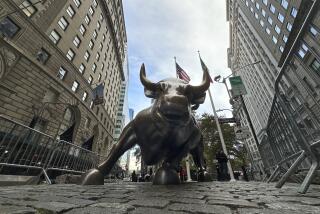Up With ‘Old-Economy’ Stocks, Down With ‘New’
- Share via
In a day that looked like a throwback to 20 years ago, old-line industrial stocks raced dramatically higher Monday even as a batch of supposedly new-era technology stocks fell into a fresh sell-off.
Transportation, basic material, financial and utility stocks rallied sharply as investors drew the conclusion--at least for a day--that the U.S. economy will manage to pull off a “soft landing” in which growth slows just enough to forestall inflation but not so much as to trigger a recession.
The Dow Jones industrial average bounded 245.15 points, or 2.3%, to 10,835.77 on the back of robust gains in Alcoa, International Paper, Caterpillar and other cyclical stocks whose fortunes depend heavily on the state of the economy. The rally built on Friday’s surge, when the Dow jumped 210 points. The index has now moved up in seven of the last eight sessions, rising 8.6% in that time.
On Monday, Alcoa rocketed $3.25, or 13%, to $28.25, International Paper jumped $2.75, or 8.3%, to $36 and Caterpillar surged $2.06, or 6.3%, to $34.94.
But the battered tech sector slumped anew as investors continued to ditch many of the highly valued issues that had been among the last buoyant tech names. Though it rallied off its worst levels of the day, the Nasdaq composite index still lost 86.96 points, or 2.7%, to end at 3,191.40--the lowest since Oct. 18.
The drop was spearheaded by tech titan Cisco Systems, which sagged 5.2% after Lehman Bros. cut its price target for the stock.
In what Wall Street chart-watchers view as a negative sign, Cisco’s shares fell below a critical “support” price level of about $50, losing $2.63 to close at $48.06.
Many other tech stocks succumbed to selling pressure. JDS Uniphase dropped $5.94, or 7.7%, to $71.31, Corning skidded $5, or 6.6%, to $71, Veritas Software gave back $8.63, or 6.1%, to $132.13 and Brocade Communications slid $18.58, or 8.2%, to $207.92.
Overall, analysts said, the weakness in those tech names might be bullish longer term because it could set the stage for a recovery in the sector later this year or early next year.
Historically, market bottoms often have occurred only after the strongest stocks fall prey to selling. The logic is that investors part with their favorite stocks only after they’ve already dumped everything else. At that point, selling abates and buyers feel comfortable moving back into fallen shares.
After generally withstanding the turmoil around them for much of the last two months, networking and fiber-optics shares such as JDS and Brocade have been hammered by investors in the last week after the surprise announcement by Nortel Networks that its third-quarter revenue was shy of analysts’ estimates.
Given the declines in those stocks, “We are definitely closer to the end of the sell-off” in tech than to the beginning, argued Jeffrey Warantz, equity strategist at Salomon Smith Barney in New York.
Monday, however, belonged to “old-economy” stocks--the kind that ruled the market in the 1980s. At the forefront Monday were the cyclical companies that fare well in a robust economy. The normally staid Morgan Stanley Dean Witter cyclical-stock index leaped an improbable 5.9% for the day.
Besides buying industrial names, investors snapped up financial issues such as Allstate, which rose $2.75 to $40; airline issues such as Delta, which jumped $4.44 to $47.69; and retailers such as Safeway, which surged $3.31 to $54.06.
In a sign of how broad-based the gains were in old-economy names, advancing stocks outnumbered declining issues on the New York Stock Exchange by 19 to 10 amid relatively heavy volume.
By comparison, falling stocks outnumbered gainers by 21 to 17 on Nasdaq, where volume was moderate at 1.7 billion shares.
The hot performance of old-line shares took some analysts by surprise. Though Wall Street clings to the hope that the economy will accomplish a soft landing, it’s far from certain that it can.
“I find it a little mystifying, actually,” said Charles Blood, market analyst at Brown Bros. Harriman & Co. “There’s a little bit of schizophrenia [in the market] about whether this is a soft landing or a hard landing.”
Blood and others attributed the nascent resurgence in old-economy stocks to several factors wholly unrelated to any belief in the vibrancy of the economy.
“Whenever tech comes under pressure, anything ‘anti-tech’ seems to get a play,” Blood said. “It may not be any more complicated than that.”
Equally important, the valuations of cyclical stocks withered in the late 1999 tech run-up and have slumped further in this year’s weak market. Indeed, even with Monday’s surge, the Morgan Stanley cyclical-stock index is only back to its mid-September level and remains 24% below its May 1999 peak.
What’s more, given the often subdued trading in many heavy-industry stocks compared with tech issues, “It doesn’t take much money to move [cyclical stocks] pretty fast,” Blood said.
The move in old-economy stocks also is due in part to the Oct. 31 end of the tax year for mutual funds, experts said. With funds having finished much of their tax-related selling, many are sitting on cash they want to put to work. And with many tech stocks still mired in a downturn, there are relatively limited options as to how to deploy the money, experts said.
Old-economy stocks might continue to rally in the next few weeks, but it’s far from certain that they are in line for an extended jump, said Richard Cripps, chief market strategist at Legg Mason Wood Walker in Baltimore.
“The rallies for these stocks [in recent years] have been very significant but very short-term in duration,” he pointed out.
Market Roundup, C13-14
More to Read
Inside the business of entertainment
The Wide Shot brings you news, analysis and insights on everything from streaming wars to production — and what it all means for the future.
You may occasionally receive promotional content from the Los Angeles Times.










